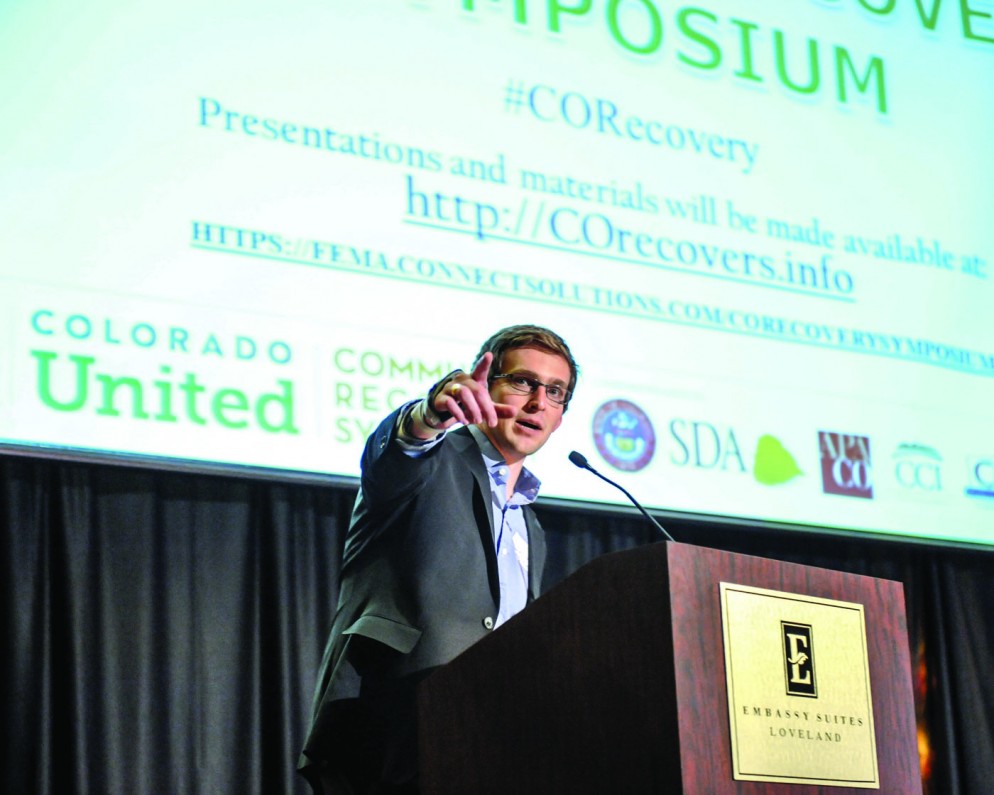On June 23, the Waldo Canyon Fire hit just a few miles from Colorado College — evacuating more than 30,000 people, destroying 347 homes, and killing two people.
Looking back, Iain, who graduated with a degree in political science, says, “It was certainly no rest at all at the beginning. . . . What’s interesting is that once you get into this [work], you don’t really even have the time to pause and think about it. You just gotta keep going. It really is about the people who are impacted in the local communities at the end of the day, so you stay focused on them. You come out of it afterward wondering how the heck you got through it.”
Waldo wasn’t the only disaster in the state at the time. Media bantered around the phrase “state on fire,” as communities evacuated thousands from homes and businesses across Colorado, from Boulder and Fort Collins to Grand Junction and Lake George.
By January 2013, Iain was promoted again to state disaster recovery manager, and the challenges continued to grow. In June, the Black Forest Fire north of Colorado Springs claimed two lives and more than 500 homes — now considered the most destructive fire in state history.
And then the rains began.
“In September 2013, we had the worst natural disaster the state has ever experienced,” he says, referring to catastrophic flooding brought on by the extreme rainfall in Boulder, Larimer, and El Paso counties, among others.
According to Iain, total damages across the state are close to $3 billion in housing, infrastructure, and economic impact. Part of his most recent promotion, in May to deputy chief recovery officer in Gov. John Hickenlooper’s Colorado Recovery Office, is to help maintain a sense of urgency about the recovery process.
“The local communities have made incredible progress, but it’s going to take years and years to fully recover. Throughout this entire process we need to work collaboratively with federal agencies, other state agencies, and our local communities on any number of different issues,” he says. “As an example, [the Department of Housing and Urban Development] has provided the state with about $262 million to support recovery efforts — another $58 million will be forthcoming soon.
“We’ve been coordinating with our state partners to put an action plan for those funds together, and done a lot of intensive public outreach to make sure the plan meets local needs. The funding is helping to rebuild or fix damaged housing and infrastructure, provide grants and loans to businesses impacted in places like Manitou Springs, and support watershed restoration efforts from Colorado Springs all the way north to Fort Collins.”
“Another thing that we’re working hard on is trying to identify ways that we can make our state and our local communities more resilient in the future so that we don’t witness the same impacts the next time it rains like it did last September or the next time we have another wildfire like [what happened] in Colorado Springs.”
It’s a big job, and Iain laughs when asked if he saw himself doing this kind of job while a CC student.
“I had absolutely no clue at all when I graduated that this would be the field that I would work in.”
He does credit one experience in particular with setting his career course. Hurricane Katrina hit during his senior year and, with support from then-President Dick Celeste and Dean of Students Mike Edmonds, Iain led a service trip to the Gulf Coast in January 2006.
“That was just one of those truly formative experiences for me,” he says, “that even afterward I didn’t necessarily think, ‘Oh gosh, I’m going to work in emergency management or disaster recovery,’ but every time something happened after that first experience, you feel a desire to help out and it really calls to you.
“I think that CC had a huge role in moving me in this direction.”
Iain serves on the Alumni Association Board of Directors
